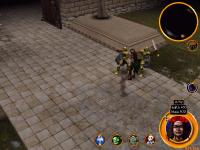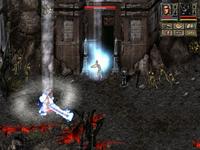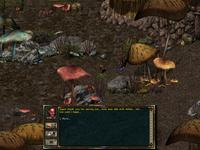|
|
|
Main News Forums Games Games Database Top 100 Release List Support Files Features Reviews Previews Interviews Editorials Diaries Misc Download Gallery Music Screenshots Videos Miscellaneous Staff Members Privacy Statement |
Larian Studios Visit: Riftrunner, part 3
We were invited by the friendly folks at Larian Studios a few weeks ago to pay them a visit and have a chance to ask questions and play Riftrunner. We arrived at Larian Studios early in the morning where Swen Vincke started the day for us by showing us some of the highlights of the game. Before you continue reading it's essential to be aware that we were shown and played a version that was in a pre-alpha stage. This in essence means that the game wasn't even in a feature freeze status, let alone that beta testing has started. So we did encounter some occasional bugs and shortcomings, but nothing serious enough that stopped us from playing the game. I'm not going to focus on those, but instead will focus on what we found to be good and not so good about Riftrunner and make sure that you are aware that as the features in the game are not frozen yet, things might change. But first let's start at the beginning (if you want to reread the first two parts of this series then you can find them here and here. Creating your character As mentioned you also get skill points with which you can select your starting skills. There is only a limited set available to you at that moment, or at least there will be in the final version. In the special version we had, we could use any skill we want. But I'll get more into the skill creation in the fourth and last part. You also have the option to select your gender/age (male, female, child), the hair and it's color, including a punk look - and your personal taste for slim, muscular, normal or fat chars. For those who would like to know: "specific" female physiology can't be changed individually, only the whole body. So there are no Lara Croft look-alikes. Finally you can enter the name you want to use for your character. Currently your character will use a predefined avatar image. Swen did mention that he would be looking into the possibility to allow for user defined image. Which would be a nice addition to the whole.
The beginning Controls Walking and running has remained unchanged from Divinity and so is accessing objects, unlocking doors and fighting. What wasn't so great was one of the inevitable side effects of having a party; they tend to get in your way. At occasion even in Divinity the pathfinding algorithm would sometimes get lost and send your character to the other side of the wall instead of opening the barrel or pulling the lever in front of it. This was mostly the case when there was some other stuff blocking some of the paths to that barrel. By making smaller steps it was then normally always possible to open that barrel or access that lever or whatever it was you wanted to do. In Riftrunner this is even more complicated because one of the other characters can stand in the way and block the path. This didn't happen frequently, just occasionally and you can always move that character away of course. The controls are just as easy as they were in Divinity and look similar too. You can do everything with your mouse and you can assign hotkeys to most of the operations if you like also, like saving and loading. The good news with respect to that is that the loading and saving times are shorter than in Divinity. The save games are also smaller, which is probably one of the reasons it's faster. What I didn't get used to however is that after loading a game, it was automatically paused. I can imagine this can be useful to some in combat situations, but for me this ‘feature' simply doesn't do it. In the few hours I played I always forgot that it was in pause mode. In all likelihood I'll probably get used to it, but I really hope that they will make this configurable, so that I can set it in such a way that things immediately continue after loading a game. Quests and puzzles
At occasion there were also puzzles that can only be solved because you have a party member. One of them involved the pulling of levers that opened and closed doors in such a way that you could not solve it without a party. Then there were also objects that could be tackled more easily by the two of you instead of doing things alone. Like in Divinity there is the usual amount of keys that unlock doors, levers that do the same and even crystal balls that you need to collect throughout one of the level in the dungeon in order to get a gateway out of that level to open. Sometimes these things are obvious and sometimes they are not. What is helpful at times are the writings on the wall, which you find rather frequently. However in order to understand these writings you need to learn the language first. You accomplish this by locating three books that are scattered throughout the first part of the dungeon. After you have read all three of them you have mastered the language and can read those scribbles. You will also find a book somewhere that will teach you how to detect traps. This is a very useful skill as after you found that book the number of traps start to increase also and there is no way you can find and avoid them without having that skill. Graphics and Music As to the music we can be short about that. It didn't exist at that time of writing and even though the music in a game can pull you more in the game, the part we played was exciting enough to not miss the music and sounds too much. It goes without saying that the final game will have music of course.
Average Reader Ratings: 6.68 (19 votes) |
|||||
|
All original content of this site is copyrighted by RPGWatch. Copying or reproducing of any part of this site is strictly prohibited. Taking anything from this site without authorisation will be considered stealing and we'll be forced to visit you and jump on your legs until you give it back. |
||







